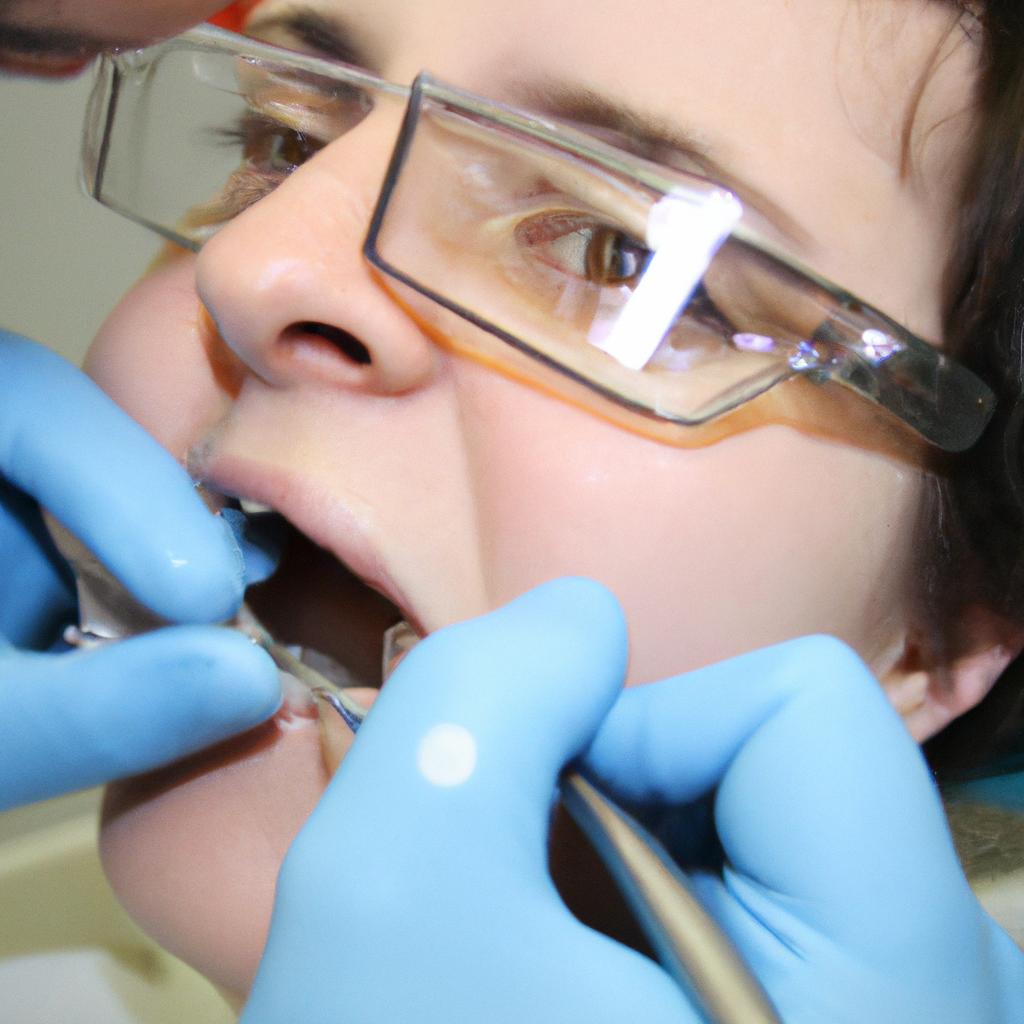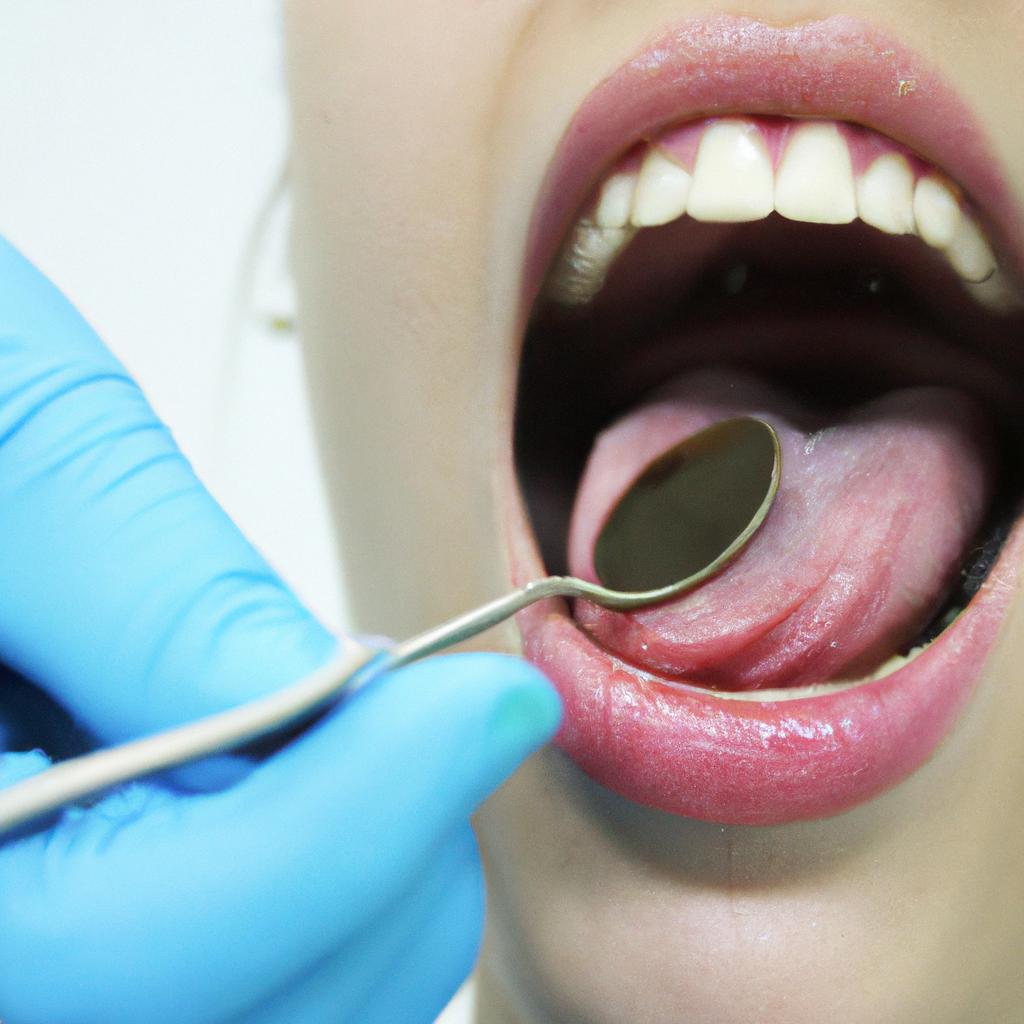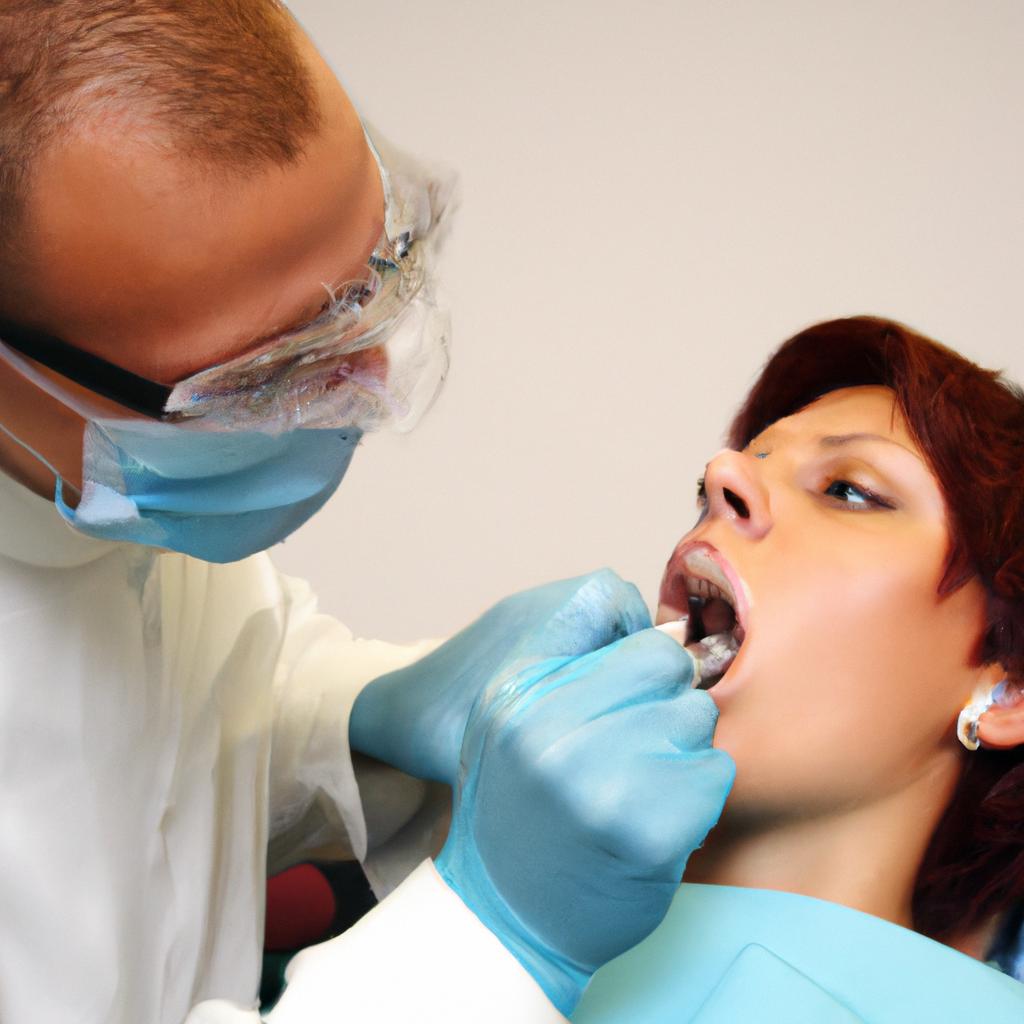Periodontitis: A Comprehensive Guide for Dental Specialists in Periodontics
Periodontitis, a chronic inflammatory disease affecting the supporting structures of teeth, poses significant challenges for dental specialists in periodontics. This comprehensive guide aims to provide practitioners with valuable insights into the etiology, diagnosis, and management of this condition. By exploring its multifactorial nature and discussing evidence-based treatment approaches, this article seeks to enhance the understanding and clinical skills of dental professionals.
To illustrate the relevance of this guide, let us consider a hypothetical case study. Imagine a middle-aged individual presenting at a periodontal clinic with bleeding gums, loose teeth, and persistent bad breath. As the examination progresses, it becomes apparent that these symptoms are indicative of advanced periodontitis. While such cases may initially seem daunting, an in-depth knowledge of the underlying mechanisms driving this disease can empower dental specialists to develop tailored treatment plans that address each patient’s unique needs effectively.
In light of the complexities surrounding periodontitis and its potential impact on oral health and overall well-being, it is crucial for dental specialists in periodontics to stay updated with current research findings and best practices. Through an exploration of etiological factors including microbial colonization and host immune response as well as diagnostic methods such as radiographic imaging and clinical measurements, this comprehensive guide aims to equip practitioners with the necessary tools to accurately diagnose periodontitis and develop evidence-based treatment plans.
One aspect that this guide emphasizes is the importance of a multidisciplinary approach in managing periodontitis. Collaboration with other dental specialists, such as prosthodontists and orthodontists, can help address any functional or aesthetic concerns that may arise during treatment. Additionally, close communication with the patient’s primary care physician may be necessary to ensure optimal management of systemic conditions that can influence the progression of periodontitis.
Treatment strategies discussed in this guide include non-surgical interventions such as scaling and root planing, adjunctive therapies like locally administered antimicrobials, and surgical procedures such as pocket reduction surgery or regenerative techniques. By understanding the indications and limitations of each approach, dental professionals can tailor their treatment plans to maximize outcomes for each individual patient.
This comprehensive guide also addresses the importance of patient education and preventive measures in managing periodontitis. Empowering patients with knowledge about proper oral hygiene techniques, lifestyle modifications (such as smoking cessation), and regular professional maintenance visits can significantly contribute to long-term success in preventing disease recurrence.
In conclusion, this comprehensive guide provides valuable insights into the etiology, diagnosis, and management of periodontitis. By exploring its multifactorial nature and discussing evidence-based treatment approaches, dental specialists in periodontics can enhance their understanding and clinical skills in addressing this chronic inflammatory disease effectively. Staying updated with current research findings and engaging in a multidisciplinary approach will ultimately lead to improved outcomes for patients suffering from periodontitis.
Understanding Periodontitis
Periodontitis is a common chronic inflammatory disease that affects the supporting structures of teeth, including the gums and underlying bone. It is characterized by the destruction of periodontal tissues due to bacterial infection, leading to tooth loss if left untreated. To illustrate its impact, let’s consider a hypothetical case study: Mr. Smith, a middle-aged individual with poor oral hygiene habits, presents with bleeding gums, bad breath, and loose teeth. Upon examination, his dentist diagnoses him with severe periodontitis.
To fully comprehend the nature of periodontitis, it is essential to understand its various aspects. Firstly, one must recognize the signs and symptoms associated with this condition. Bleeding gums during brushing or flossing, persistent bad breath (halitosis), receding gum line, formation of deep pockets between teeth and gums are some typical indications observed in patients affected by periodontitis.
Secondly, it is crucial to acknowledge the emotional toll that periodontitis can have on individuals’ quality of life. Here are some key points to consider:
- Psychological distress: The visible effects of advanced periodontitis such as tooth loss or disfigurement can lead to feelings of embarrassment and self-consciousness.
- Reduced social interactions: Individuals may shy away from social situations due to concerns about their appearance or fear of judgment.
- Impact on daily activities: Eating difficulties caused by loose teeth or discomfort while chewing can significantly affect an individual’s ability to enjoy meals.
- Decreased self-esteem: The physical changes resulting from periodontitis can erode an individual’s confidence and overall sense of self-worth.
Furthermore, understanding the progression and consequences of periodontitis requires knowledge about risk factors associated with its development. These factors include smoking tobacco products, poor oral hygiene practices, genetic predisposition towards gum diseases, certain systemic conditions like diabetes or immunodeficiency disorders, hormonal changes (such as during pregnancy), stress, and obesity. By identifying these risk factors, dental professionals can implement preventive measures and provide appropriate treatment strategies tailored to each patient.
In the subsequent section on “Causes and Risk Factors,” we will explore in detail how certain behaviors, genetic predispositions, and systemic conditions contribute to the development of periodontitis. This understanding is crucial for effective management and prevention of this debilitating disease.
Causes and Risk Factors
Periodontitis is a chronic inflammatory disease that affects the supporting structures of teeth, including the gums and bone. As dental specialists in periodontics, it is crucial to have a comprehensive understanding of this condition in order to provide effective treatment and care for our patients.
To illustrate the impact of periodontitis, let’s consider a hypothetical case study. Sarah, a 45-year-old woman with a history of poor oral hygiene practices, presents with bleeding gums and persistent bad breath. Upon examination, we observe deep periodontal pockets and significant bone loss around several teeth. This scenario highlights the importance of early detection and intervention in preventing further progression of periodontitis.
Several factors contribute to the development and progression of periodontitis. These include:
- Plaque accumulation: The primary cause of periodontal diseases is bacterial plaque buildup on tooth surfaces. Inadequate oral hygiene allows bacteria to flourish, leading to inflammation and tissue destruction.
- Genetics: Certain genetic variations can increase an individual’s susceptibility to developing severe forms of periodontitis.
- Smoking: Tobacco use not only impairs blood flow to the gums but also weakens the body’s immune response against infection, making smokers more prone to periodontal disease.
- Systemic conditions: Conditions such as diabetes or immunodeficiency disorders compromise the body’s ability to fight infections, thereby increasing the risk of developing or worsening periodontitis.
The emotional toll that periodontitis can take on individuals should not be overlooked. It can lead to diminished self-esteem due to aesthetic concerns arising from tooth loss or gum recession. Furthermore, pain and discomfort associated with advanced stages of the disease can significantly impair one’s quality of life.
Emotional Response Bulleted List:
- Anxiety about social interactions
- Frustration over limitations in eating certain foods
- Embarrassment regarding bad breath or visible signs of gum disease
- Fear of tooth loss and its impact on overall oral health
Table: Emotional Impact of Periodontitis
| Emotions | Implications |
|---|---|
| Anxiety | Social isolation, reduced self-confidence |
| Frustration | Dietary restrictions, dissatisfaction with appearance |
| Embarrassment | Negative impact on personal relationships, avoidance of social situations |
| Fear | Dental anxiety, reluctance to seek treatment |
As dental specialists in periodontics, it is our responsibility to address not only the physical manifestations but also the emotional aspects associated with periodontitis. By recognizing the potential psychological burden that patients may experience, we can provide empathetic care and support throughout their treatment journey.
In the subsequent section, we will discuss the signs and symptoms of periodontitis, crucial for early detection and prompt intervention. Understanding these indicators will further aid us in providing comprehensive care to our patients.
Signs and Symptoms
In the previous section, we explored the causes and risk factors associated with periodontitis. Now, let us delve deeper into understanding the signs and symptoms of this oral condition.
Imagine a patient named John who has been experiencing persistent bad breath despite maintaining good oral hygiene practices. This example serves to highlight one of the common signs of periodontitis that patients may encounter. In addition to halitosis, other notable signs include redness and swelling of gums, bleeding during brushing or flossing, gum recession, loose teeth, and formation of deep pockets between teeth and gums.
Recognizing these signs is crucial as early detection can help prevent further progression of the disease. To aid in identifying potential cases of periodontitis, dental specialists should be aware of certain key indicators:
- Persistent gingival inflammation: The presence of chronic inflammation in the gums is a strong indication of periodontal disease.
- Poor plaque control: Insufficient removal of plaque leads to its accumulation on tooth surfaces and subsequent bacterial growth.
- Smoking: Cigarette smoking increases the risk for periodontitis due to compromised immune response and impaired blood flow.
- Systemic diseases: Conditions such as diabetes and cardiovascular diseases have been linked to an increased susceptibility to periodontal infections.
To provide a comprehensive overview, here is a table summarizing some common signs and their corresponding implications:
| Sign | Implication |
|---|---|
| Persistent bad breath | Possible underlying periodontal infection |
| Redness and swelling | Inflammation indicating gum disease |
| Bleeding upon brushing | Early-stage sign requiring prompt attention |
| Gum recession | Progressive loss of gum attachment |
Understanding these signs aids dental specialists in diagnosing periodontitis promptly. By recognizing the connection between these indications and their implications, professionals can initiate appropriate treatment plans tailored to each patient’s needs.
Transitioning into the subsequent section about “Diagnosis and Assessment,” dental specialists utilize a combination of clinical examination, radiographic evaluation, and periodontal probing to establish an accurate diagnosis. This comprehensive approach ensures that no aspect of the patient’s condition is overlooked, enabling effective management and treatment strategies moving forward.
Diagnosis and Assessment
To effectively manage periodontitis, dental specialists in periodontics must possess a thorough understanding of the diagnostic process and assessment techniques. By employing a systematic approach, clinicians can accurately identify the severity of the disease, develop appropriate treatment plans, and monitor patients’ progress over time. This section will explore key aspects of diagnosing and assessing periodontitis.
Case Study:
Consider a hypothetical case where a 45-year-old patient presents with complaints of bleeding gums while brushing and bad breath. Upon examination, deep pockets are observed around multiple teeth along with localized gum recession. Radiographic imaging reveals vertical bone loss in certain areas. These findings suggest a potential diagnosis of advanced chronic periodontitis.
Diagnostic Tools and Techniques:
In order to confirm the presence and extent of periodontal diseases, dental specialists employ various tools and techniques during their assessment. These include:
- Periodontal probing: Accurate measurement of pocket depths allows for classification of disease severity.
- Clinical attachment level (CAL) evaluation: Assessing CAL provides information about the amount of tooth structure that has been lost due to attachment loss.
- Radiographic analysis: X-rays help visualize bone levels around teeth and determine if there is any evidence of bone loss.
- Microbiological testing: Identifying specific bacterial pathogens through microbial analysis aids in determining an individual’s risk for disease progression.
The diagnosis and assessment process can evoke different emotions in both patients and dental specialists:
- Anxiety: Patients may feel anxious about potential treatment options or fear associated with receiving a definitive diagnosis.
- Relief: Obtaining a proper diagnosis brings relief as it helps explain symptoms experienced by the patient.
- Empowerment: Understanding the condition empowers patients to actively participate in their own oral health management.
- Confidence: Dental specialists gain confidence when armed with accurate diagnostic information, enabling them to provide targeted treatment recommendations.
Table – Stages of Periodontitis:
| Stage | Description |
|---|---|
| Stage I | Initial periodontal lesion, characterized by inflammation and mild attachment loss. |
| Stage II | Moderate periodontitis with noticeable bone loss and increased pocket depths. |
| Stage III | Severe periodontitis where significant tooth support structures are compromised. |
| Stage IV | Advanced stage of disease with extensive bone loss and high risk for tooth loss. |
By thoroughly diagnosing and assessing the severity of periodontitis, dental specialists can accurately determine appropriate treatment options. Let us now delve into various strategies available in managing this condition effectively.
Treatment Options
Section Title: Diagnosis and Assessment
Transition from previous section H2
Building upon the foundations of accurate diagnosis, periodontal specialists play a crucial role in assessing the severity and extent of periodontitis. By employing various diagnostic methods and tools, dental professionals can effectively evaluate the condition’s scope and tailor treatment plans accordingly.
Example to engage readers
Consider a hypothetical case study involving a 45-year-old patient presenting with symptoms such as bleeding gums, persistent bad breath, and loose teeth. Upon examination, probing depths ranging from 5mm to 9mm reveal significant attachment loss and bone destruction. This scenario highlights the importance of thorough diagnosis and assessment for an optimal management approach.
Diagnostic methods utilized by dental specialists include but are not limited to:
- Comprehensive medical history review
- Clinical examinations (e.g., visual inspection, probing)
- Radiographic imaging (e.g., X-rays, cone-beam computed tomography)
- Microbiological testing
These approaches allow experts in periodontics to accurately determine disease severity, identify contributing factors like plaque accumulation or systemic conditions, assess tissue inflammation levels, and detect potential complications that may affect treatment outcomes.
| Periodontal Diagnostic Methods | Key Benefits |
|---|---|
| Medical History Review | Identify risk factors associated with periodontitis |
| Clinical Examinations | Evaluate gingival health status and pocket depth |
| Radiographic Imaging | Assess bone loss patterns and anatomical structures |
| Microbiological Testing | Determine specific bacteria present in oral biofilm |
While these diagnostic modalities provide valuable insights into patients’ periodontal health status, it is essential for dental specialists to interpret findings within a comprehensive context. Factors such as age, overall health condition, smoking habits, genetic predisposition, patient compliance with oral hygiene practices contribute significantly to the prognosis and success of treatment interventions.
By employing a systematic and evidence-based approach to diagnosis and assessment, dental specialists in periodontics can ensure accurate evaluation of periodontitis severity, leading to effective treatment planning. This comprehensive understanding serves as the foundation for the subsequent section on “Treatment Options,” where various therapeutic strategies will be explored.
Transition into the subsequent section about “Preventive Measures”
Understanding the importance of early detection and intervention in managing periodontal diseases lays the groundwork for discussing preventive measures aimed at minimizing disease progression while optimizing oral health outcomes.
Preventive Measures
In the previous section, we discussed various treatment options for periodontitis. Now let us shift our focus towards preventive measures that can help in avoiding or minimizing the risk of developing this condition.
To illustrate the importance of preventive measures, consider a hypothetical case study involving a 45-year-old individual named John. Despite receiving extensive treatment for his severe periodontal disease, he continues to experience recurrent infections and tooth loss. This case highlights the significance of adopting effective preventive strategies to maintain oral health and prevent further complications.
Prevention is key when it comes to combating periodontitis. Here are some essential measures that individuals can take:
- Maintain proper oral hygiene: Regularly brushing teeth at least twice a day with fluoride toothpaste and using dental floss or interdental brushes to clean between teeth can significantly reduce plaque accumulation.
- Adopt a healthy lifestyle: A balanced diet rich in fruits, vegetables, whole grains, and low in sugary snacks or beverages helps support overall gum health by providing essential nutrients.
- Avoid tobacco use: Smoking and chewing tobacco increase the risk of developing periodontitis and hinder its successful treatment. Quitting these habits plays a crucial role in preventing the progression of the disease.
- Scheduling regular dental visits: Routine dental check-ups allow early detection and intervention of any signs of gum disease, enabling timely management.
Furthermore, here is an emotionally evocative bullet point list summarizing how practicing preventive measures benefits individuals:
- Reduces pain associated with advanced gum disease
- Preserves natural teeth and prevents tooth loss
- Improves overall quality of life by enhancing self-confidence
- Saves significant costs on expensive treatments
Let’s also present an emotionally impactful table highlighting statistics related to untreated periodontitis:
| Statistics | Impact |
|---|---|
| Tooth Loss | Major Consequence |
| Linked to Systemic Diseases | Alarming Connection |
| Increased Healthcare Costs | Financial Burden |
| Impact on Mental Well-being | Emotional Toll |
By implementing effective preventive measures, individuals can take control of their oral health and minimize the risk of developing periodontitis. This proactive approach not only improves overall well-being but also serves as a cost-effective strategy in the long run.
In summary, embracing preventive measures is crucial for avoiding the onset or progression of periodontitis. By adopting good oral hygiene practices, making healthy lifestyle choices, quitting tobacco use, and scheduling regular dental visits, individuals can significantly reduce the likelihood of developing this chronic condition. Taking these steps empowers individuals to maintain optimal oral health and enjoy an improved quality of life while minimizing potential financial burdens associated with advanced gum disease.






